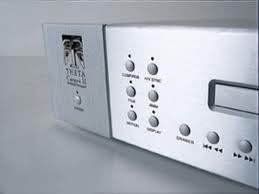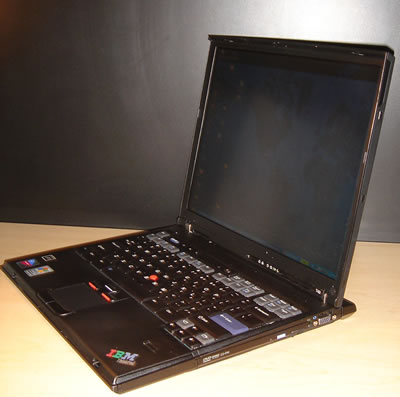by Kevin OBrien on 6/13/2011
THETA CARMEN II CD TRANSPORT VS. IBM T43 LAPTOP
I am comparing my IBM Thinkpad T43 laptop to my Theta Digital Carmen II CD transport. I am wondering which is a better digital source component. I will be describing my findings after setting up the IBM T43 for use with my M2Tech Evo USB to SPDIF converter. This allows my laptop to become another digital source component with a digital output just like a CD transport. I will NOT be using the USB input on my DAC. This allows me to switch between older and newer DACs that do not possess a USB input.

It has come to my attention that the best way to hook up a CD transport to a DAC is through the AES/ EBU digital output or the BNC digital output if possible. The RCA digital output inherently introduces too much jitter. I will be implementing the Theta Carmen II's AES/ EBU digital output hooked up to an EE Minimax DAC via a Better Cables Silver Serpent balanced digital cable. I will be implementing the IBM T43/ M2Tech EVO hooked up to an EE Minimax DAC via a Black Cat Cable Veloce BNC digital cable. The USB cable linking the EVO and the IBM will be the 1 meter Silnote Audio Poseidon Silver Reference USB. I will be toggling back and forth between the two components by selecting the corresponding input on the Minimax DAC.
First, let me describe my IBM T43 laptop. It is not in the stock form. I have installed 2GB of RAM and added a more recent 350GB HDD to accommodate my digital files library. The computer comes with a 1.83 GHz Pentium M 750 processor which has NOT been overclocked. I am running XP Service Pack 3 for an operating system with all Windows sounds and standby modes turned off. I also unplug the laptop from the internet so Windows will not check for updates (The computer is allowed to update itself before and after listening sessions). I am implementing the Foobar 2000 digital media player with the Kernel Streaming Plug-In installed. This allows me to output a bit-perfect digital stream via USB to the M2Tech EVO. From the EVO the Veloce 75 ohm BNC digital cable sends the data to the DAC. Simple enough.

Let me describe my Foobar 2000 set-up as well to let you know the basic settings I am using as there are a lot of options within the program. I have the output files set to play at 24 bits and my buffer is set to somewhere near the middle of the supplied range. I turn off all the Replay Gain settings and do not fade in or out of tracks. I want the most dumbed down settings I can get so I alter the original sound of the digital files as little as possible. There is an ongoing debate on whether Foobar or JRiver sounds better. I have heard from both sides that each is better for several reasons. I am sticking with Foobar since it costs me nothing to use. Feel free to experiment but be aware that JRiver will set you back $50 for the non-trial version. Now that we've covered the laptop set-up let's talk about the files I'm playing within Foobar 2000.
I use the EAC CD ripping software mainly because it's free and I am not familiar with the Foobar ripping software yet. I have heard Foobar is the way to go in terms of sound quality but I'm pretty sure EAC is very close. I choose to rip CDs directly to WAV files so I know I am playing the exact same quality file as on the CD. Some folks choose to use FLAC files but I am hesitant to go that route. I do not want to compromise performance in any way and WAVs seem like a safe bet to me. If you are interested in hi-res digital files you can buy them from HDTracks.com. They sell a variety of digital FLAC files in a variety of formats such as: 16/44.1, 24/44.1, 24/48, 24/88, 24/96, 24/176, and 24/192. Make sure your DAC can play all these formats BEFORE you purchase. The EVO can handle every available format right now so I do not have to worry. Unfortunately, not all DACs can handle 24/192 digital input streams from a digital cable other than USB. A lot of DACs and SPDIF converters are only compatible with files that are 24/96 or less. Do your homework! I want to mention Media Monkey here as well since that is the software I use to convert my FLAC files from HDTracks.com to WAVs. It's a nice program in that it keeps the sampling rates of the source FLAC files intact when converting to WAV files. A 24/96 FLAC file turns into a 24/96 WAV file. Very cool.
So, about the sound already. I let things warm up for a while before doing any serious listening. It turns out that comparing the two sources wasn't as easy as I thought. Switching back and forth between the sources was easy but I could not tell a night and day difference between them. I did notice right away that the laptop had more mid-range detail. I kept listening and flip-flopping between the two sources and I realized the computer was giving me a better mid-range response to my ears but that was the main difference. Keep in mind I am comparing 16/44.1 WAV files to the same CD. If we are talking about 24/96 files, the computer beats the same CD every time. To me, it makes sense to go with the laptop for ease of use. CDs are not difficult to load but they can become a pain when they get dirty or scratched. A CD transport laser can become stuck, not track correctly, or fail, etc. When my laptop breaks, I will just buy another one. If my CD transport breaks, I cannot afford to go out and spend just under $4000 on a new one and Theta no longer supports any legacy products. The decision was easy for me. I'm moving in the direction of the future, not the past. I still love vinyl but I don't think vinyl can beat a great music server.
-KOB
Associated Equipment for this Review:
- Von Schweikert VR-5 HSE (Hovland Special Edition) Speakers
- Quicksilver 12AX7 Tubed Linestage and Silver 60 Monoblocks
- EE Minimax DAC
- EE Minimax Phono Stage
- VPI Scoutmaster Turntable with VPI Zephyr Cartridge
- PS Audio PPP/ Equitech 1.5Q COMBO
- YFS Custom Cables & Interconnects
- YFS Custom Room Treatment
- Herbies Audio Lab Dampening Devices and Tube Dampers
